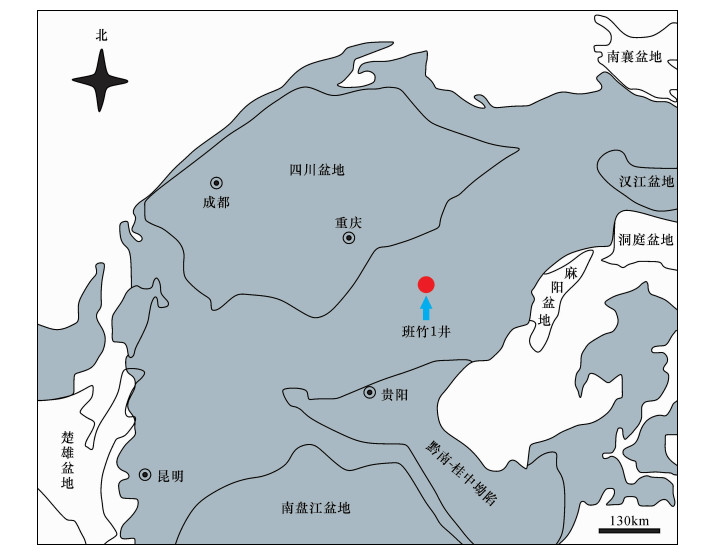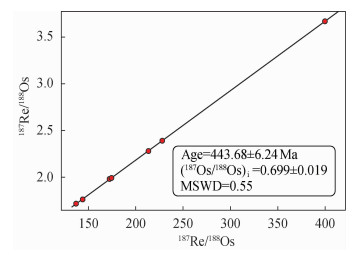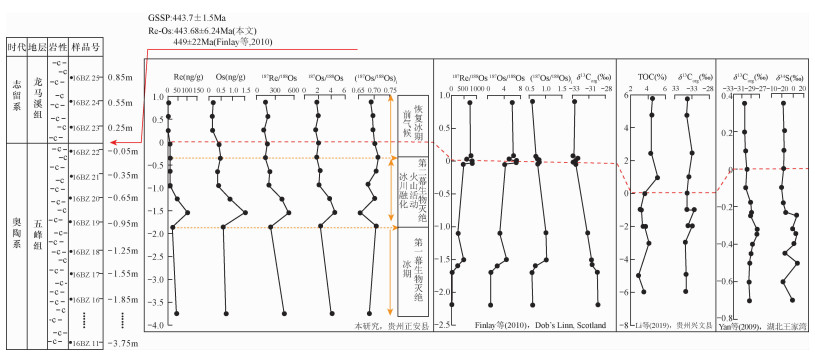Accurate Determination of the Age of the Carbonaceous Mudstone of the Ordovician-Silurian Boundary in Zheng'an County, Guizhou Province by Re-Os Isotope Dating Method and Its Application in Paleoenvironmental Inversion
-
摘要: 我国上扬子地台地区在奥陶系—志留系之交广泛发育蕴含丰富页岩气资源的五峰组—龙马溪组富有机质沉积岩。采用Re-Os同位素体系对该套沉积地层进行研究,不仅能得到精确的地层沉积年龄,同时根据Re、Os元素的富集机制,对该时期沉积环境进行有效反演,可以为这一阶段发生的地球历史上第二大规模的生物绝灭事件的触发机制提供更合理的解释。本文在贵州正安县班竹1井岩心采集11件碳质泥岩样品,岩心样品连续且完整跨越奥陶系五峰组—志留系龙马溪组界线地层,通过对该样品开展高精度Re-Os同位素研究,获得了奥陶系—志留系地层界线Re-Os同位素年龄为443.68±6.24Ma[2σ,n=7,(187Os/188Os)i=0.699±0.019,MSWD=0.55],其结果与国际地层委员会发布的年龄(443.7±1.5Ma)高度一致,为奥陶系—志留系界线年龄提供了直接、准确的年龄依据。Os同位素特征反映了大量陆源碎屑参与成岩过程、多期火山活动的发生及冰期向间冰期的转换。连续沉积地层Re-Os同位素特征的变化反映了研究区奥陶系五峰组—志留系龙马溪组沉积环境经历富氧—缺氧—富氧的变化,指示赫南特期冰川事件和火山喷发共同造成了生物大绝灭并促进了有机质的富集,为五峰组—龙马溪组富有机质沉积岩提供了生烃潜力。
-
关键词:
- Re-Os同位素定年 /
- 奥陶系—志留系界线 /
- Os同位素特征 /
- 古环境演化 /
- 五峰组—龙马溪组富有机质沉积岩 /
- 热电离质谱法
Abstract:BACKGROUNDOrganic-rich sedimentary rocks of the Wufeng-Longmaxi Formation are widely developed in the Ordovician-Silurian boundary of the Upper Yangtze platform in China, which is rich in shale gas resources. Using the Re-Os isotope system to study this set of sedimentary formations, not only can the precise age of the formation be obtained, but also the sedimentary environment of this period based on the enrichment mechanism of Re and Os elements can be inferred. This provides a more reasonable explanation for the trigger mechanism of the second large-scale biological extinction event in Earth's history. OBJECTIVESTo accurately constrain the age of carbonaceous mudstone and infer the conditions of the paleoenvironment. METHODSThe 11 carbonaceous mudstone samples from dirll core of Banzhu No.1, Zheng'an County, Guizhou Province were studied. These dirll core samples were continuous across the boundary of the Ordovician Wufeng Formation-Silurian Longmaxi Formation. Through the high precision Re-Os isotopic dating of the 11 samples, the Ordovician-Silurian boundary stratigraphic age was obtained. RESULTSThe Re-Os isotope age was calculated to be 443.68±6.24Ma[2σ, n=7, (187Os/188Os)i=0.699±0.019, MSWD=0.55]. The results were highly consistent with the age (443.7±1.5Ma) published by the International Commission on Stratigraphy, which provided a direct and accurate age basis for the Ordovician-Silurian boundary. Os isotope characteristics showed that amounts of terrigenous detrital were involved in the diagenesis, the occurrence of multi-stage volcanic activities and the transition from glacial period to interglacial period. The Re-Os isotopic features of the continuous sedimentary strata reflected that the sedimentary environment of the Ordovician Wufeng Formation-Silurian Longmaxi Formation had undergone the change of oxygen enrichment-oxygen enrichment-rich oxygen enrichment in this study area. CONCLUSIONSHirnantian glaciation events and volcanic eruption caused biological extinction and together promoted organic matter enrichment, providing hydrocarbon generation potential for the Wufeng Formation-Longmaxi Formation organic-rich sedimentary rocks. -

-
表 1 奥陶系—志留系界线碳质泥岩Re-Os同位素结果
Table 1. Re-Os isotope data of carbonaceous mudstone in the Ordovician—Silurian boundary
碳质泥岩样品编号 采样深度
(m)Re含量(ng/g) Os含量(ng/g) 187Re/188Os 187Os/188Os (187Os/188Os)i 测定值 不确定度 测定值 不确定度 测定值 不确定度 测定值 不确定度 16BZ-11 1120.15 43.76 0.32 0.7166 0.0054 440.9 4.5 3.950 0.008 0.6846 16BZ-16 1118.25 22.17 0.16 0.6084 0.0046 227.6 2.3 2.394 0.004 0.7058 16BZ-17 1117.95 101.3 0.7 1.497 0.011 509.6 5.2 4.437 0.007 0.6563 16BZ-18 1117.65 49.12 0.36 0.8658 0.0065 399.7 4.0 3.668 0.006 0.7027 16BZ-19 1117.35 12.21 0.09 0.3854 0.0029 192.0 1.9 2.104 0.004 0.6798 16BZ-20 1117.05 12.36 0.09 0.3596 0.0027 212.2 2.1 2.281 0.004 0.7061 16BZ-21 1116.75 11.18 0.08 0.4773 0.0036 136.4 1.4 1.725 0.003 0.7125 16BZ-22 1116.45 11.65 0.09 0.4048 0.0031 172.1 1.7 1.979 0.003 0.7026 16BZ-23 1116.15 3.315 0.196 0.1558 0.0012 122.2 7.3 1.604 0.003 0.6965 16BZ-24 1115.85 3.848 0.028 0.1323 0.0010 174.3 1.8 1.988 0.004 0.6947 16BZ-25 1115.55 4.350 0.032 0.1764 0.0013 144.1 1.5 1.758 0.003 0.6884 注:(187Os/188Os)(i)=187Os/188Os-(et×10-5×1.666-1)×187Re/188Os;t=443.7Ma(据Jenkins et al., 2002[30])。 -
[1] Tucker R D, Krogh T E, Ross R J, et al.Time-scale calibration by high-precision U-Pb zircon dating of interstratified volcanic ashes in the Ordovician and Lower Silurian stratotypes of Britain[J].Earth and Planetary Science Letters, 1990, 100(1-3):51-58. doi: 10.1016/0012-821X(90)90175-W
[2] Ghavidel-Syooki M, Hassanzadeh J, Vecoli M.Paly-nology and isotope geochronology of the Upper Ordovician-Silurian successions (Ghelli and Soltan Maidan Formations) in the Khoshyeilagh area, Eastern Alborz Range, Northern Iran; Stratigraphic and palaeogeographic implications[J].Review of Palaeobotany & Palynology, 2011, 164(3-4):251-271.
[3] Cramer B D, Condon D J, Soderlund U, et al.U-Pb (zircon) age constraints on the timing and duration of Wenlock (Silurian) paleocommunity collapse and recovery during the 'Big Crisis'[J].Geological Society of America Bulletin, 2012, 124(11-12):1841-1857. doi: 10.1130/B30642.1
[4] Cooper M R, Crowley Q, Rushton A W A.New age constraints for the Ordovician Tyrone volcanic group, Northern Ireland[J].Journal of the Geological Society, 2008, 165(1):1-19. doi: 10.1144/0016-76492007-072
[5] 胡艳华, 刘健, 周明忠, 等.奥陶纪与志留纪钾质斑脱岩研究评述[J].地球化学, 2009, 38(4):393-404. doi: 10.3321/j.issn:0379-1726.2009.04.010
Hu Y H, Liu J, Zhou M Z, et al.An overview of Ordovician and Silurian K-bentonites[J].Geochimica, 2009, 38(4):393-404. doi: 10.3321/j.issn:0379-1726.2009.04.010
[6] Hu Y H, Zhou J B, Song B, et al.SHRIMP zircon U-Pb dating from K-bentonite in the top of Ordovician of Wangjiawan Section, Yichang, Hubei, China[J].Science in China Series D (Earth Sciences), 2008, 51(4):493-498. doi: 10.1007/s11430-008-0028-1
[7] Li Y F, Zhang T W, Shao D Y, et al.New U-Pb zircon age and carbon isotope records from the Lower Silurian Longmaxi Formation on the Yangtze Platform, South China:Implications for stratigraphic correlation and environmental change[J].Chemical Geology, 2019, 509:249-260. doi: 10.1016/j.chemgeo.2019.02.003
[8] 罗华, 何仁亮, 潘龙克, 等.湖北宣恩县麻阳寨晚奥陶-早志留世龙马溪组斑脱岩LA-ICP-MS锆石U-Pb年龄及其地质意义[J].资源环境与工程, 2016, 30(4):547-550. http://d.old.wanfangdata.com.cn/Periodical/hbdk201604001
Luo H, He R L, Pan L K, et al.LA-ICP-MS zircon U-Pb age and its significance of Late Ordovician-Early Silurian Longmaxi bentonite[J].Resources Environment & Engineering, 2016, 30(4):547-550. http://d.old.wanfangdata.com.cn/Periodical/hbdk201604001
[9] 谢尚克, 汪正江, 王剑, 等.湖南桃源郝坪奥陶系五峰组顶部斑脱岩LA-ICP-MS锆石U-Pb年龄[J].沉积与特提斯地质, 2012, 32(4):65-69. doi: 10.3969/j.issn.1009-3850.2012.04.010
Xie S K, Wang Z J, Wang J, et al.LA-ICP-MS zircon U-Pb dating of the bentonites from the uppermost part of the Ordovician Wufeng Formation in the Haoping Section, Taoyuan, Hunan[J].Sedimentary Geology and Tethyan Geology, 2012, 32(4):65-69. doi: 10.3969/j.issn.1009-3850.2012.04.010
[10] 熊国庆, 王剑, 李园园, 等.大巴山西段上奥陶统-下志留统五峰组-龙马溪组斑脱岩锆石U-Pb年龄及其地质意义[J].沉积与特提斯地质, 2017, 37(2):46-58. doi: 10.3969/j.issn.1009-3850.2017.02.006
Xiong G Q, Wang J, Li Y Y, et al.Zircon U-Pb dating and geological significance of the bentonites from the Upper Ordovician Wufeng Formation and Lower Silurian Longmaxi Formation in Western Daba Mountains[J].Sedimentary Geology and Tethyan Geology, 2017, 37(2):46-58. doi: 10.3969/j.issn.1009-3850.2017.02.006
[11] 熊国庆, 王剑, 李园园, 等.南大巴山东段上奥陶统五峰组-下志留统龙马溪组钾质斑脱岩锆石U-Pb年龄及其构造意义[J].地质学报, 2019, 93(4):843-864. http://d.old.wanfangdata.com.cn/Periodical/dizhixb201904007
Xiong G Q, Wang J, Li Y Y, et al.Zircon U-Pb dating of K-bentonite from Late Ordovician Wufeng Formation and Earlier Silurian Longmaxi Formation in the eastern section of South Dabashan and its tectonic sigification[J].Acta Geologica Sinica, 2019, 93(4):843-864. http://d.old.wanfangdata.com.cn/Periodical/dizhixb201904007
[12] Ge X Y, Mou C L, Wang C S, et al.Mineralogical and geochemical characteristics of K-bentonites from the Late Ordovician to the Early Silurian in South China and their geological significance[J].Geological Journal, 2019, 54(1):514-528. doi: 10.1002/gj.3201
[13] 卢斌, 邱振, 周杰, 等.四川盆地及周缘五峰组-龙马溪组钾质斑脱岩特征及其地质意义[J].地质科学, 2017, 52(1):186-202. http://www.wanfangdata.com.cn/details/detail.do?_type=perio&id=dzkx201701013
Lu B, Qiu Z, Zhou J, et al.The characteristics and Wufeng Formation and geological significance of the K-bentonite in Longmaxi Formation in Sichuan Basin and its peripheral areas[J].Chinese Journal of Geology, 2017, 52(1):186-202. http://www.wanfangdata.com.cn/details/detail.do?_type=perio&id=dzkx201701013
[14] Yan D T, Chen D Z, Wang Q C, et al.Carbon and sulfur isotopic anomalies across the Ordovician-Silurian boundary on the Yangtze Platform, South China[J].Palaeogeography, Palaeoclimatology, Palaeoecology, 2009, 274(1-2):32-39. doi: 10.1016/j.palaeo.2008.12.016
[15] Wang K, Chatterton B D E, Wang Y.An organic carbon isotope record of Late Ordovician to Early Silurian marine sedimentary rocks, Yangtze Sea, South China:Implications for CO2 changes during the Hirnantian glaciation[J].Palaeogeography, Palaeoclimatology, Palaeoecology, 1997, 132(1-4):147-158. doi: 10.1016/S0031-0182(97)00046-1
[16] Delabroye A, Munnecke A, Vecoli M, et al. Phytoplankton dynamics across the Ordovician/Silurian boundary at low palaeolatitudes:Correlations with carbon isotopic and glacial events[J].Palaeogeography, Palaeoclimatology, Palaeoecology, 2011, 312(1-2):0-97.
[17] Fan J, Peng P, Melchin M J.Carbon isotopes and event stratigraphy near the Ordovician-Silurian boundary, Yichang, South China[J].Palaeogeography, Palaeoclimatology, Palaeoecology, 2009, 276(1-4):160-169. doi: 10.1016/j.palaeo.2009.03.007
[18] Liu Y, Li C, Algeo T J, et al.Global and regional controls on marine redox changes across the Ordovician-Silurian boundary in South China[J].Palaeogeography, Palaeoclimatology, Palaeoecology, 2016, 463:180-191. doi: 10.1016/j.palaeo.2016.10.006
[19] 汪啸风, 柴之芳.奥陶系与志留系界线处生物绝灭事件及其与铱和碳同位素异常的关系[J].地质学报, 1989, 60(3):65-74. http://www.cnki.com.cn/Article/CJFDTotal-DZXE198903006.htm
Wang X F, Chai Z F.Terminal Ordovician mass extinction and its relationship to iridium and carbon isotope anomalies[J].Acta Geologica Sinica, 1989, 60(3):65-74. http://www.cnki.com.cn/Article/CJFDTotal-DZXE198903006.htm
[20] Chen X, Rong J Y, Charles E, et al.Late Ordovician to Earliest Silurian graptolite and brachiopod biozonation from the Yangtze Region, South China, with a global correlation[J].Geological Magazine, 2000, 137(6):623-650. doi: 10.1017/S0016756800004702
[21] 林家善, 刘建清, 冯伟明, 等.黔北下志留统龙马溪组烃源岩有机地球化学特征及其古环境意义[J].沉积与特提斯地质, 2014, 34(2):79-85. http://d.old.wanfangdata.com.cn/Periodical/yxgdl201402012
Lin J S, Liu J Q, Feng W M, et al.Organic geochemical signatures and palaeo-environmental implications for the source rocks from the Lower Silurian Longmaxi Formation in Northern Guizhou[J].Sedimentary Geology and Tethyan Geology, 2014, 34(2):79-85. http://d.old.wanfangdata.com.cn/Periodical/yxgdl201402012
[22] 王辰, 刘建朝, 张海东, 等.湘西花垣地区奥陶-志留系沉积岩稀土元素地球化学特征及地质意义[J].矿物岩石地球化学通报, 2017, 36(3):534-595. http://d.old.wanfangdata.com.cn/Periodical/kwysdqhxtb201703018
Wang C, Liu J C, Zhang H D, et al.REE geochemical characteristics of Ordovician-Silurian sedimentary rocks in the Huayuan Area, Hunan Province and their geological significances[J].Bulletin of Mineralogy, Petrology and Geochemistry, 2017, 36(3):534-595. http://d.old.wanfangdata.com.cn/Periodical/kwysdqhxtb201703018
[23] Yan D T, Chen D Z, Wang Q C, et al.Large-scale climatic fluctuations in the Latest Ordovician on the Yangtze Block, South China[J].Geology, 2010, 38(7):599-602. doi: 10.1130/G30961.1
[24] Gong Q, Wang X, Zhao L, et al.Mercury spikes suggest volcanic driver of the Ordovician-Silurian mass extinction[J].Scientific Reports, 2017, 7(1):5304-5310. doi: 10.1038/s41598-017-05524-5
[25] Jones D S, Martini A M, Fike D A, et al.A volcanic trigger for the Late Ordovician mass extinction? Mercury data from South China and Laurentia[J].Geology, 2017, 45(7):631-634. doi: 10.1130/G38940.1
[26] Finlay A J, Sebly D, Gröcke D R.Tracking the Hirnantian glaciation using Os isotopes[J].Earth and Planetary Science Letters, 2010, 293(3-4):339-348. doi: 10.1016/j.epsl.2010.02.049
[27] 李超, 屈文俊, 王登红, 等.Re-Os同位素在沉积地层精确定年及古环境反演中的应用进展[J].地球学报, 2014, 35(4):405-414. http://d.old.wanfangdata.com.cn/Periodical/dqxb201404005
Li C, Qu W J, Wang D H, et al.The progress of applying Re-Os isotope to dating of organic-rich sedimentary rocks and reconstruction of palaeoenvironment[J].Acta Geoscientica Sinica, 2014, 35(4):405-414. http://d.old.wanfangdata.com.cn/Periodical/dqxb201404005
[28] 李欣尉, 杨显德, 李超, 等.蒸馏法富集纯化Os实验条件研究及其在负离子热电离质谱测量中的应用[J].岩矿测试, 2018, 37(4):102-110. http://www.ykcs.ac.cn/article/doi/10.15898/j.cnki.11-2131/td.201805020054
Li X W, Yang X D, Li C, et al.Study on the conditions for enrichment and purification of Os by microdistillation and its application in NTIMS measurements[J].Rock and Mineral Analysis, 2018, 37(4):102-110. http://www.ykcs.ac.cn/article/doi/10.15898/j.cnki.11-2131/td.201805020054
[29] 李超, 王登红, 周利敏, 等.湖南鲁塘石墨矿Re-Os同位素研究[J].岩矿测试, 2017, 36(3):297-304. http://www.ykcs.ac.cn/article/doi/10.15898/j.cnki.11-2131/td.201704060050
Li C, Wang D H, Zhou L M, et al.Study on the Re-Os isotope composition of graphite from the Lutang graphite deposit in Hunan Province[J].Rock and Mineral Analysis, 2017, 36(3):297-304. http://www.ykcs.ac.cn/article/doi/10.15898/j.cnki.11-2131/td.201704060050
[30] Jenkins R J F, Acooper J, Compston W.Age and biostratigraphy of Early Cambrian tuffs from SE Australia and Southern China[J].Journal of the Geological Society, 2002, 159(6):645-658. doi: 10.1144/0016-764901-127
[31] Lanphere M A, Churkin M, Eberlein G D.Radiometric age of the monograptus cyphus graptolite zone in Southeastern Alaska-An estimate of the age of the Ordovician-Silurian boundary[J].Geological Magazine, 1977, 114(1):15-24. doi: 10.1017/S0016756800043387
[32] Fullager P D, Bottino M L.Radiometric age of the volcanics at Arisaig, Nova Scotia, and the Ordovician-Silurian boundary[J].Canadian Journal of Earth Sciencen, 1968, 5(2):311-317. doi: 10.1139/e68-031
[33] Jaffe L A, Peucker-Ehrenbrink B, Petsch S T.Mobility of rhenium, platinum group elements and organic carbon during black shale weathering[J].Earth and Planetary Science Letters, 2002, 198(3-4):339-353. doi: 10.1016/S0012-821X(02)00526-5
[34] Creaser R A, Sannigrahi P, Chacko T, et al.Further evaluation of the Re-Os geochronometer in organic-rich sedimentary rocks:A test of hydrocarbon maturation effects in the Exshaw Formation, Western Canada Sedimentary Basin[J].Geochimica et Cosmochimica Acta, 2002, 66(19):3441-3452. doi: 10.1016/S0016-7037(02)00939-0
[35] 李超, 屈文俊, 王登红, 等.富有机质地质样品Re-Os同位素体系研究进展[J].岩石矿物学杂志, 2010, 29(4):421-430. doi: 10.3969/j.issn.1000-6524.2010.04.009
Li C, Qu W J, Wang D H, et al.Advances in the study of the Re-Os isotopic system of organic-rich samples[J].Acta Petrologica et Mineralogica, 2010, 29(4):421-430. doi: 10.3969/j.issn.1000-6524.2010.04.009
[36] Kendall B, Creaser R A, Sebly D.187Re-187Os Geochronology of Precambrian Organic-rich Sedimentary Rocks[M].London:Geological Society, 2009, 326:85-107.
[37] 徐伦勋, 肖传桃, 龚文平, 等.论扬子地区上奥陶统五峰组观音桥段的深海成因[J].地质学报, 2004, 78(6):726-732. doi: 10.3321/j.issn:0001-5717.2004.06.002
Xu L X, Xiao C T, Gong W P, et al.A study on the deep-sea sediment of the Guanyinqiao Member of the Upper Ordovician Wufeng Formation in the Yangtze Area[J].Acta Geologica Sinica, 2004, 78(6):726-732. doi: 10.3321/j.issn:0001-5717.2004.06.002
[38] 王同, 杨克明, 熊亮, 等.川南地区五峰组-龙马溪组页岩层序地层及其对储层的控制[J].石油学报, 2015, 36(8):915-925. http://www.cnki.com.cn/Article/CJFDTotal-SYXB201508003.htm
Wang T, Yang K M, Xiong L, et al.Shale sequence stratigraphy of Wufeng-Longmaxi Formation in Southern Sichuan and their control on reservoirs[J].Acta Petrolei Sinica, 2015, 36(8):915-925. http://www.cnki.com.cn/Article/CJFDTotal-SYXB201508003.htm
[39] Cohen A S.The rhenium-osmium isotope system:Applications to geochronological and palaeoenviron-mental problems[J].Journal of the Geological Society, 2004, 161(4):729-734. doi: 10.1144/0016-764903-084
[40] Levasseur S, Birck J, Allegre C J.Direct measurement of femtomoles of osmium and the 187Os/186Os ratio in seawater[J].Science, 1998, 282(5387):272-274. doi: 10.1126/science.282.5387.272
[41] 赵鸿, 李超, 江小均, 等.浙江长兴"金钉子"灰岩Re-Os富集机制研究[J].地质学报, 2015, 89(10):1783-1791. doi: 10.3969/j.issn.0001-5717.2015.10.006
Zhao H, Li C, Jiang X J, et al.Direct radiometric dating of limestone from Changxing Permian-Triassic Boundary using the Re-Os geochronometer[J].Acta Geologica Sinica, 2015, 89(10):1783-1791. doi: 10.3969/j.issn.0001-5717.2015.10.006
[42] Trotter J A, Williams I S, Barnes C R, et al.Did cooling oceans trigger Ordovician biodiversification? Evidence from conodont thermometry[J].Science, 2008, 321(5888):550-554. doi: 10.1126/science.1155814
[43] Finnegan S, Bergmann K, Eiler J M, et al.The magnitude and duration of Late Ordovician-Early Silurian glaciation[J].Science, 2011, 331(6019):903-906. doi: 10.1126/science.1200803
[44] Finnegan S, Heim N A, Peters S E, et al.Climate change and the selective signature of the Late Ordovician mass extinction[J].Proceedings of the National Academy of Science, 2012, 109(18):6829-6834. doi: 10.1073/pnas.1117039109
[45] Zhou L, Algeo T J, Shen J, et al.Changes in marine productivity and redox conditions during the Late Ordovician Hirnantian glaciation[J].Palaeogeography, Palaeoclimatology, Palaeoecology, 2015, 420:223-234. doi: 10.1016/j.palaeo.2014.12.012
[46] Cramer B D, Saltzman M R.Sequestration of 12C in the deep ocean during the Early Wenlock (Silurian) positive carbon isotope excursion[J].Palaeogeography, Palaeoclimatology, Palaeoecology, 2005, 219(3-4):333-349. doi: 10.1016/j.palaeo.2005.01.009
[47] Saltzman M R, Young S A.Long-lived glaciation in the Late Ordovician? Isotopic and sequence-stratigraphic evidence from Western Laurentia[J].Geology, 2005, 33(2):109-112. doi: 10.1130/G21219.1
[48] Young S A, Saltzman M R, Bergström S A.Upper Ordovician (Mohawkian) carbon isotope (δ13C) stratigraphy in Eastern and Central North America:Regional expression of a perturbation of the global carbon cycle[J].Palaeogeography, Palaeoceanography, Palaeoclimatology, 2005, 222(1-2):53-76. doi: 10.1016/j.palaeo.2005.03.008
[49] Sheehan P M.The Late Ordovician mass extinction[J].Annual Reviews of Earth and Planetary Sciences, 2001, 29(29):331-364. http://d.old.wanfangdata.com.cn/OAPaper/oai_pubmedcentral.nih.gov_3345012
[50] Rasmussen C M Ø, Harper D A T.Interrogation of distributional data for the End Ordovician crisis interval:Where did disaster strike?[J].Geological Journal, 2011, 46(5):478-500.
[51] Luo G, Algeo T J, Zhan R, et al.Perturbation of the marine nitrogen cycle during the Late Ordovician glaciation and mass extinction[J].Palaeogeography, Palaeoclimatology, Palaeoecology, 2016, 448:339-348. doi: 10.1016/j.palaeo.2015.07.018
[52] Melchin M J, Holmden C.Carbon isotope chemostra-tigraphy of the Llandovery in Arctic Canada:Implications for global correlation and sea-level change[J].GFF, 2006, 128(2):173-180. doi: 10.1080/11035890601282173
[53] Underwood C J, Crowley S F, Marshall J D, et al.High-resolution carbon isotope stratigraphy of the basal Silurian stratotype (Dob's Linn, Scotland) and its global correlation[J].Journal of the Geological Society, 1997, 154(4):709-718. doi: 10.1144/gsjgs.154.4.0709
[54] Kaljo D, Martma T, Mannik P, et al.Implications of Gondwana glaciations in the Baltic Late Ordovician and Silurian and a carbon isotopic test of environmental cyclicity[J].Bulletin de la Société Géologique de France, 2003, 174(1):59-66. doi: 10.2113/174.1.59
[55] Vecoli M, Riboulleau A, Versteegh G J M.Palynology, organic geochemistry and carbon isotope analysis of a Latest Ordovician through Silurian clastic succession from borehole Tt1, Ghadamis Basin, Southern Tunisia, North Africa:Palaeoenvironmental interpretation[J].Palaeogeography, Palaeoclimatology, Palaeoecology, 2009, 273(3-4):378-394. doi: 10.1016/j.palaeo.2008.05.015
[56] Munnecke A, Samtleben C, Bickert T.The Ireviken Event in the Lower Silurian of Gotland, Swede-relation to similar Palaeozoic and Proterozoic events[J].Palaeogeography, Palaeoclimatology, Palaeoecology, 2003, 195(1):99-124.
[57] Cramer B D, Brett C E, Melchin M J, et al.Revised correlation of the Silurian provincial series of North America with global and regional chronostratigraphic units and δ13Ccarb chemostratigraphy[J].Lethaia, 2011, 44(2):185-202. doi: 10.1111/j.1502-3931.2010.00234.x
-




 下载:
下载:

